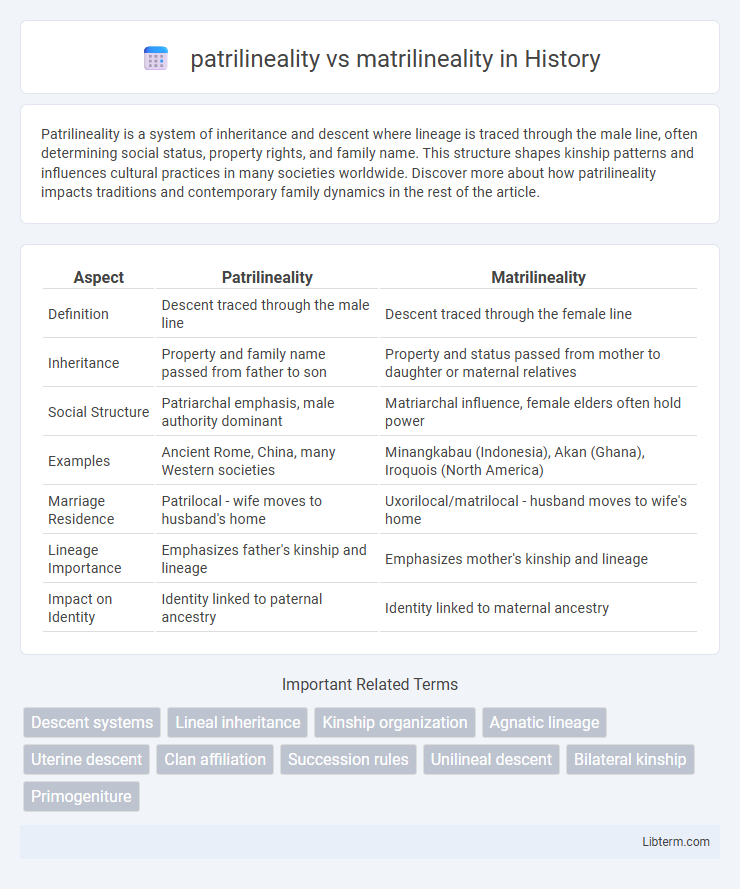Patrilineality is a system of inheritance and descent where lineage is traced through the male line, often determining social status, property rights, and family name. This structure shapes kinship patterns and influences cultural practices in many societies worldwide. Discover more about how patrilineality impacts traditions and contemporary family dynamics in the rest of the article.
Table of Comparison
| Aspect | Patrilineality | Matrilineality |
|---|---|---|
| Definition | Descent traced through the male line | Descent traced through the female line |
| Inheritance | Property and family name passed from father to son | Property and status passed from mother to daughter or maternal relatives |
| Social Structure | Patriarchal emphasis, male authority dominant | Matriarchal influence, female elders often hold power |
| Examples | Ancient Rome, China, many Western societies | Minangkabau (Indonesia), Akan (Ghana), Iroquois (North America) |
| Marriage Residence | Patrilocal - wife moves to husband's home | Uxorilocal/matrilocal - husband moves to wife's home |
| Lineage Importance | Emphasizes father's kinship and lineage | Emphasizes mother's kinship and lineage |
| Impact on Identity | Identity linked to paternal ancestry | Identity linked to maternal ancestry |
Introduction to Patrilineality and Matrilineality
Patrilineality refers to a social system where lineage, inheritance, and family ties are traced through the male line, often emphasizing male authority and succession. Matrilineality, in contrast, traces descent through the female line, shaping inheritance patterns and social organization around mothers and maternal relatives. These kinship systems influence cultural norms, property rights, and identity formation within various societies worldwide.
Defining Patrilineal and Matrilineal Descent
Patrilineal descent traces lineage exclusively through the male line, emphasizing inheritance, family name, and social identity passed from fathers to sons. Matrilineal descent, by contrast, follows the female line, where lineage, property, and social status are inherited from mothers to their children, often influencing clan membership and residence patterns. These systems shape kinship, inheritance rights, and cultural practices across societies, reflecting distinct social organization and gender roles.
Historical Origins of Lineal Systems
Patrilineality, historically prevalent in agrarian and pastoral societies, traces descent through the male line, reinforcing inheritance and family name succession tied to land and wealth control. Matrilineality, often found in horticultural and some indigenous societies, emphasizes lineage through the female line, linking inheritance and social status to maternal relatives and promoting clan cohesion. Archaeological and anthropological studies reveal that these lineal systems evolved in response to economic strategies, resource distribution, and social organization, shaping kinship patterns and political structures across civilizations.
Cultural Variations Across Societies
Patrilineality and matrilineality represent distinct kinship systems that influence inheritance, residence patterns, and social organization across diverse cultures. Societies practicing patrilineality, such as many traditional East Asian and Middle Eastern communities, trace lineage and property through the male line, emphasizing paternal authority and descent. In contrast, matrilineal cultures, found among groups like the Akan in Ghana and the Navajo in North America, assign lineage through the female line, often granting women significant social and economic roles within their communities.
Gender Roles in Patrilineal and Matrilineal Systems
Patrilineal systems emphasize male authority, inheritance, and lineage, often assigning women domestic roles and limiting their social power, while matrilineal systems trace descent through the female line, frequently granting women greater control over property and family matters. In patrilineal societies, males typically dominate decision-making and leadership positions, contrasting with matrilineal communities where women's kinship ties and economic influence shape social structure. Gender roles in these systems reflect underlying cultural values about authority, inheritance, and familial responsibilities, impacting status and power distribution between men and women.
Inheritance Patterns and Family Structures
Patrilineality centers inheritance and lineage through the male line, where property, family name, and social status pass from father to son, reinforcing male authority within family structures. Matrilineality emphasizes descent through the female line, with inheritance, clan membership, and family ties traced via the mother, often granting women significant roles in family continuity and resource control. These distinct patterns influence kinship organization, residence norms, and social roles, shaping cultural identity and power distribution across generations.
Social and Economic Impacts
Patrilineality often reinforces male dominance in inheritance, property rights, and social status, shaping patriarchal economic structures where wealth and power concentrate along the male line. Matrilineality, by contrast, allocates inheritance and lineage through women, frequently enhancing female authority in household management and resource distribution, which can lead to more balanced gender roles and cooperative social networks. These distinct systems significantly influence marriage patterns, alliance formation, and community cohesion, affecting labor organization and economic stability within societies.
Transformation of Lineal Traditions in Modern Times
Patrilineality and matrilineality represent distinct inheritance and kinship systems where descent is traced through the father's or mother's line, respectively. Modern transformations reveal a shift as urbanization, legal reforms, and gender equality movements challenge traditional lineal norms, promoting bilateral or flexible lineage identification. Digital record-keeping and globalization further dilute strict patrilineal and matrilineal structures, fostering hybrid kinship forms adapted to contemporary societal needs.
Challenges and Critiques of Lineality Systems
Patrilineality systems often face criticism for perpetuating gender inequality by prioritizing male inheritance and lineage, which can marginalize women's social and economic rights. Matrilineality challenges traditional patriarchal norms but may encounter difficulties in societies structured around male-dominated power dynamics, leading to conflicts over property and authority. Both systems can struggle with rigidity, limiting individuals' identity and inheritance options, raising debates over the need for more inclusive and flexible kinship models.
The Future of Lineal Descent Practices
Patrilineality, which traces lineage through the male line, dominates in many traditional societies, while matrilineality, emphasizing descent through the female line, persists in specific cultures such as the Minangkabau of Indonesia. Shifts in social structures, gender roles, and legal frameworks suggest a future where hybrid or flexible lineage systems may emerge, accommodating diverse family dynamics and inheritance patterns. Emerging anthropological research highlights increased recognition of bilateral descent practices, reflecting evolving societal values around kinship and identity in a globalized world.
patrilineality Infographic

 libterm.com
libterm.com